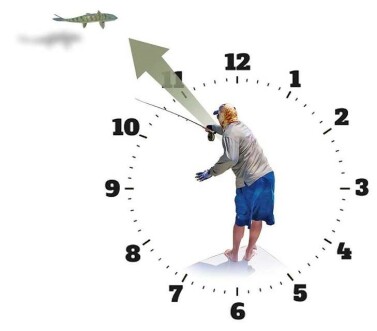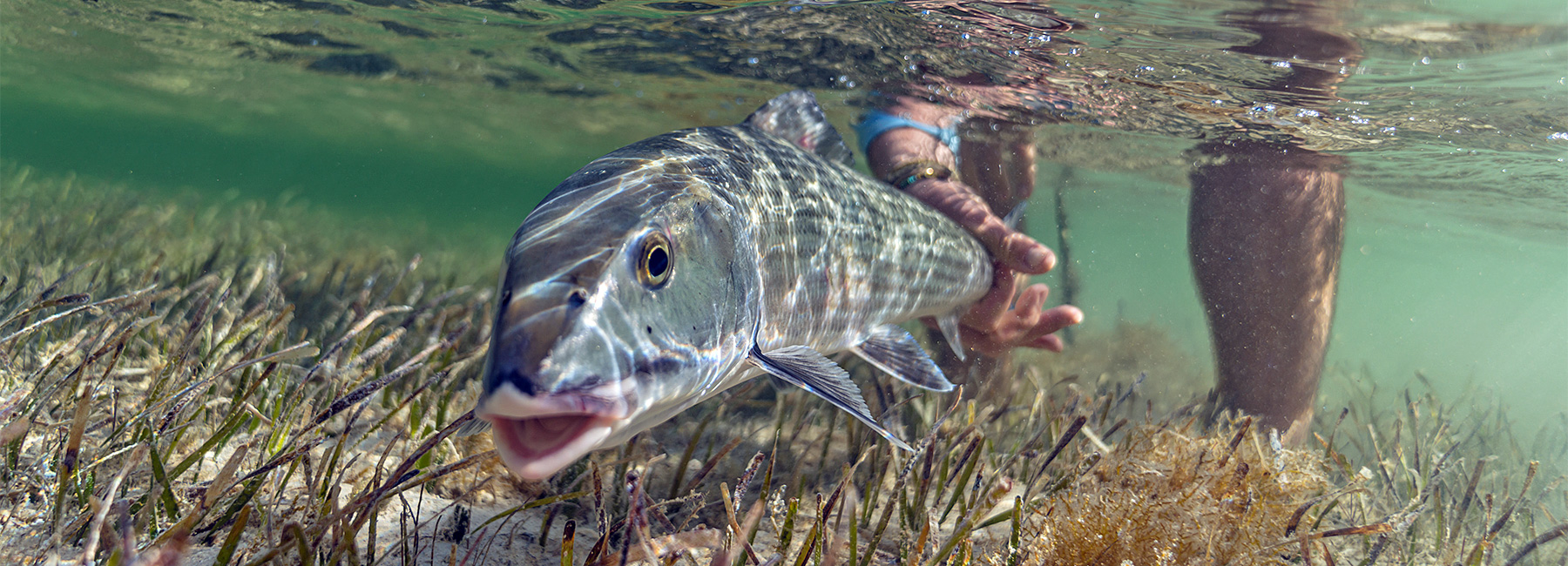Bonefish behavior
Bonefish are the target species in the Bahamas, and have three basic modes of behavior.
Feeding
Bonefish feed on the bottom, and through the water column. While feeding on very shallow flats their wavering tails are often visible out of the water. In deeper water their tails are not visible but the fish can still be seen. While bonefish are feeding, the condition of the surface of the water affects their feeling of security. Bonefish are more nervous in calm water. Conditions determine how best to present the fly. On most days there is a slight chop or ripple on the surface and the fly must be presented three to five feet in front of them. On very still days the fly should be cast further from the fish and stripped back into his area of awareness.
Mudding
During the warmer months very large schools of bonefish will often back off the shoreline into about 5 to 10 feet of cooler water. As they grub for food they stir up the bottom creating a visible cloud of mud, referred to as “milk”. This cloud of mud moves as the bonefish move and makes these bones feel quite secure because they are not visible to predators. Often the angler can catch one fish after another without spooking the school. It is generally not a common practice to fish muds because the desired challenge of sight fishing is eliminated. However, guides will fish muds with you at your request, and this can be good for beginners to feel the first lightning-fast tug of a bonefish.
Traveling
Traveling bonefish are intent on changing location, but are very aware of their surroundings and not necessarily interested in feeding. When casting to traveling bonefish place your offering well ahead of the fish and let it settle. Your guide will tell you when the fish is in range and when to strip.
Bonefishing Techniques
On the flats, your guide will be standing on the poling platform and poling the boat while scanning for fish. You will be standing on the front deck of the boat with your rod in one hand and your fly in the other.
When you are not fishing from the boat, you will be wading the flats. When wading, walk slowly and stop often to look for fish. If you see the fish moving in a specific direction, move quietly into position so you will be able to present the fly in front of the fish. You usually have more time than you think to make a precise presentation.
Bonefish are almost always moving, and movement is often the first sign of fish. Scan the water slowly from side to side, within the range that you can cast. The guide will be looking further out, responsible for finding fish at a distance and moving into a good casting position. Look for the flash of an exposed tail, nervous water, a wave or wake on top of the water, or the shadow of a cruising fish. When casting to a fish that is moving towards you, land the fly in front of the fish, let it sink while the fish moves towards it, and begin stripping when the fish is close to the fly.
Typically, the guide will see the fish before you, and will put the boat in position for your cast. You will hear him direct you to the fish by saying something like “10 o’clock, 40 feet, going left”. Point your rod where you think he is directing you, and he will often help by saying, “more left” or “more right”, and tell you when to cast.
If you do not see the fish, do not cast until your guide asks you to. He will put the boat in position for the cast, tell you how far to cast and in which direction, and when to cast. Follow his directions in when to begin stripping your fly.
After you cast, let the fly sink to the bottom and make your first strips long and slow to get the fish’s attention. Now you are going to “read the fish” by observing its behavior. If it moves quickly to your fly and stops, it probably ate your fly. Make a long strip to set the hook. If there is no resistance, stop, let the fly sink, and begin stripping again. If you do feel resistance, pull on your line to set the hook without lifting your rod, and prepare to “clear your line” as the fish runs. The first run often takes all the line quickly off the deck, and it is important that you guide the line off the deck and onto the reel. Your drag has been pre-set, so hold your rod tip high and enjoy the run! Occasionally the fish will turn and run towards you. If you can’t strip fast enough to keep a tight line, push your rod tip into the water and the drag of the fish pulling the line through the water will keep tension on the hook. Bonefish have tough mouths and having sharp hooks is important. Check your hook point regularly by pulling it across your thumb nail. If it digs into your nail, it’s sharp. If it drags across your nail without sticking, it’s time to sharpen the point. Be certain to pinch down the barbs on your hooks. This makes it easier to release fish with minimal handling, and also minimizes the risk of injury to yourself and others.
Planning & Preparing for Your Trip
The best thing you can do to get ready after booking your trip is to practice your casting. Accuracy of cast is far more important than distance. Speed of re-casting is also very important as saltwater fish tend to move
across the flats. If you have an accurate 40’ cast and can pick that fly up and recast, example from 12:00 to 2:00 to get in front of a moving school of fish, this is far better and will hook more fish, then a wild 60’ cast.
Your guides are there not only to get you into fish, but to help make your fishing trip go as smoothly as possible. They are well versed in both fly and spin fishing and know that area of Central Belize well. Some guides tend to be a bit shyer than others, and don’t want to be presumptuous, so if you need something, let them know. If you need help with your casting, the guides are experienced in fly fishing tackle. The guides will make fly recommendations and help to rig rods.
When fishing, you are on the bow of the skiff and the guide is normally on the platform at the aft. Guides use the “clock” system, and foot measurements to help you locate fish. If standing facing forward on the skiff, the bow is 12:00, hard right is 3:00 and hard left is 9:00. For foot measurements, your fly rod is approximately 9’ and a spinning rod is anywhere from 6’ to 9’. Your guide should go over this before fishing so you are both referring to the same thing – if he forgets, please remind him.
And finally, guides are people and not all have the same personalities. All of our guides know fishing and the areas to fish in Central Belize and all of our guides will work hard to get you into fish. They like when you catch fish as much as you do, if not more so. Sometimes the weather or the fish themselves are not cooperative and this is not the guide’s fault. They will be working harder to find fish in bad weather conditions.
Wading:
If you would like to wade, please let us know ahead of time, so that we can schedule you with a guide who wades. There is no wading while fishing Tarpon. If fishing for Bonefish & Permit, about 20% of our flats are wade-able. Please note, that the wade-able flats are usually the first to blow out in windy conditions.
Suggested Reference Books:
- Practical Fishing Knots II by Mark Sosin & Lefty Kreh
- Fly Fishing in Saltwater by Lefty Kreh
- Fishing the Flats by Sosin & Kreh
- Fly Fishing for Bonefish by Dick Brown
- Saltwater Fly Fishing by Jeff Currier
- Fly Fishing for Bonefish by Chico Fernandez
You & Your Guide are a Team
Please take the initiative and get to know your guide. Establish a rapport with him. Let them know what species you want to fish, how you want to fish and your abilities and fishing experience.
Check 1, 2, and 3: Let the guide check your equipment, knots, leaders, tippet material, flies, rod and reel, etc.
1.) On the flats, your guide will oftentimes spot fish before you do. When this happens, your guide will refer to the numbers on a clock to give you the fish’s general direction. For example, the bow (front) on the boat would represent 12:00 O’clock. Exactly perpendicular to the boat off of your right shoulder (starboard) would be 3:00 O’clock; perpendicular to the boat off your left shoulder (port) would be 9:00 O’clock, etc. In addition to the direction, the guide will also refer to a distance measured in feet. For example: “Okay, two fish coming at 1:00 O’clock — 50 feet”.
2.) Still on the casting platform, strip out some fly line and throw a short cast as the guide watches. Next, throw a medium cast. Lastly, throw a long cast. Ask the guide how far you just cast. Make sure you are both on the same page in judging distance. Make sure his 50ft is not your 30ft. You and the guide now know each other’s styles and abilities.
4.) If your guide spots a fish and you do not see it, DO NOT cast until you see that fish. Point your rod in front of you as if a pointer on a chalkboard and have your guide direct your rod to where he sees the fish. Your guide might say, “2 o’clock, more right, keep going, keep going STOP!” this is where you should concentrate your vision and again DO NOT cast until you see the fish.
6.) Setting the hook in saltwater fishing is very different from what most of us have learned in freshwater. You want to learn and practice the “Strip” strike or set. This is done NOT by lifting the rod tip as in trout fishing, but by keeping your rod pointed at the fish and pulling on the line, or stripping. In this way, the hook is either buried in the fish with the static line driving the hook, or at least the fly will remain in front of the fish for another chance. Lifting the rod tip will likely pull the hook out of the mouth of the fish without a hookup and spook the fish from the area. Each species of fish has subtle variations of the strip set to maximize your hook up rate with each eat. Your guide will help adjust your sets on the water, but come prepared to use this technique.

